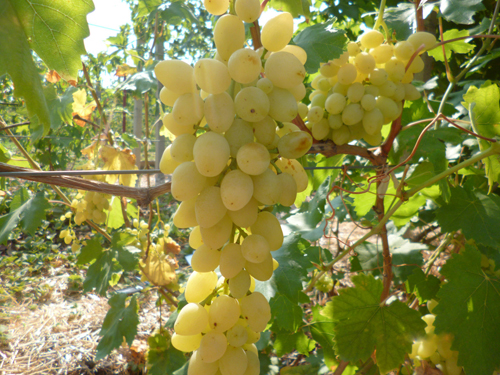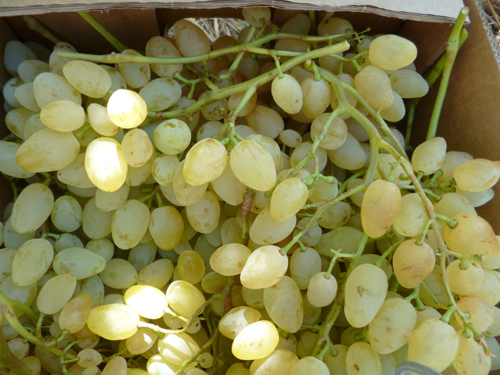Grape variety Long-awaited
The long-awaited - light-colored table grape variety, bred by one of the most famous domestic national breeders - Viktor Krainov. The variety was obtained using his favorite parental pair - Mascotchosen as the maternal form largely due to the functionally feminine type of the flower, and Radiant kishmishacting as a donor of high gastronomic and aesthetic properties of the offspring. This couple became the parents of many brainchildren of the famous explorer, including the magnificent "Troika Krainov" - Transfiguration, Anniversary of Novocherkassk and Victor.

Immediately after its appearance, the hybrid quickly gained popularity among many amateur winegrowers due to its very early ripening period, large fruit size, attractive appearance of bunches and berries, excellent taste, as well as partial seedlessness of the fruit passed on to him through the paternal line. Over time, thanks to its numerous positive qualities, the grapes received official recognition, and, having passed the state variety testing, was included in the state register of breeding achievements of the Russian Federation. Among the co-authors of the variety, an outstanding scientist from the All-Russian Research Institute of Viticulture and Winemaking Ivan Kostrikin was also included, under whose methodological guidance the amateur breeder created his masterpieces.
Agrobiological characteristics
The growth vigor of the bushes is above average. The crown of a young shoot is open, yellowish-green, without pubescence. The leaf is large, stretched in width, consists of five lobes bending downward with an average degree of dissection between them. The surface of the leaf blade is smooth, saturated green with light veins, often having a reddish tint at the base, there is a weak cobweb pubescence on the back. Top side cutouts of medium depth, slotted with parallel sides and sharp bottom, or V-shaped. The lower ones, for the most part barely outlined, but can repeat the shape of the upper notches, differing only in a much shallower depth. The petiolate notch is usually open, vaulted, with a pointed or flat bottom. The petioles of the variety are long, have intense anthocyanin pigmentation, which is why they are almost completely red in color. The teeth along the edge of the Long-awaited leaf are medium, predominantly triangular with a moderately wide base, a blunt apex and even edges. The flowers of the grapes are bisexual, which allows them to pollinate without assistance, however, in years unfavorable for flowering, up to 20% of the berries may differ in peas. Annual growth ripens very quickly and to a considerable length. In this case, the color of the shoots becomes reddish brown.
Ripe clusters are very large, loose in structure, conical in shape. The average weight of each of them is about 700-800 grams, but there are also more massive specimens. The combs are not too long, herbaceous, but quite strong. The bulk of grape berries grows very large, ovoid or oblong-nipple-shaped, pleasant to the eye, yellow, weighing 8-10 grams. The bunches of this variety do not differ in high uniformity of grapes, but at the same time, due to the not too dense brush, deformation and damage of the berries against each other does not occur. Their flesh is quite dense, juicy-fleshy, pleasant harmonious taste with a neutral aroma. The squeezed juice is colorless, sugar content 15-16 g / 100 ml and titratable acidity 5-6 g / l. The skin is thin, for this reason it is felt weak when eating. Covered on the outside with a light whitish prune bloom. The seeds are not found in all berries, which gives the tasting an element of surprise and increases the average taste ratings of the fruit. According to the results of variety testing, this indicator was fixed at around 8.6 points.

The main purpose of the crop is fresh consumption. Due to its external data and excellent taste, the Long-awaited one can certainly be classified as a "market" variety that is popular with farmers who cultivate grapes for sale. They especially value early-ripening varieties, which yield a harvest during a period of high prices, which ensures an increased profitability of their cultivation in comparison with forms that bear fruit during a period of oversaturation of the market with grapes. Our hero rarely lingers on the shelves, since buyers quickly appreciate his gastronomic qualities and especially partial seedlessness. In addition, it is also distinguished by good transportability, which means it can be transported over long distances, which expands the possibilities of its implementation. The bunches are also suitable for storage in the assembled form, the main condition for this is their careful, accurate collection and the creation of an optimal microclimate in the room in terms of temperature and humidity. Hobbyists who grow the variety for their own needs in personal plots often use surplus crops to prepare harvests for the winter. In this regard, our hero also shows himself only from the best side.
The long-awaited one belongs to the category of early ripening because of the very short growing season from the day of budding to the onset of removable ripeness - 105-115 days. For example, in the lower Don region, harvesting begins in the first decade of August. The heat demand of plants, calculated as the sum of active temperatures, is also quite modest, fluctuating between 2200-2300 ° C. This fact allows us to evaluate the variety as very plastic, capable of growing and bearing fruit in the open field, not only in traditional wine-growing regions, but also much further north, up to the Moscow region. This possibility is confirmed by numerous amateurs cultivating it in various parts of our country and neighboring countries. It is worth noting here that the frost resistance of the bushes at −22 ... −23 ° С does not allow them to be cultivated in northern latitudes without shelter, but this fact does not at all frighten winegrowers who want to cultivate high-quality grapes, albeit in a covering culture.
In addition to the excellent quality characteristics of the fruits, the variety also demonstrates excellent yield indicators. In the course of state variety testing, on average, 202 centners of the crop were obtained per hectare of plantations. As for amateur plantings, with good care, many growers achieve productivity up to 15 or more kilograms per bush. Like other large-fruited varieties, the Long-awaited one suffers from a tendency to overload, in which an excessive number of brushes are laid on the plants, surpassing the strength of the bushes themselves. If you do not take measures to normalize the load, the problem can manifest itself in the form of a decrease in the strength of growth and ripening of shoots, lengthening of the growing season, deterioration of sugar accumulation in berries and a decrease in their taste properties. Ignoring these signals for several years can result in the death of weakened plants.

With regard to the possibility of long-term presence of ripe grapes on the vine after ripening, the opinions of winegrowers are ambiguous. Some argue that as a result, the pulp of overripe berries softens and becomes watery, while others, based on their own experience, argue that nothing of the kind happens to them. It is quite possible that the reason for the deterioration in consistency is not the fact of late harvesting itself, but the weather conditions that accompany this, which differ both from year to year and from region to region. In rainy weather, for example, the hybrid not only liquefies the pulp, but the skin of the grapes can crack, spoiling the presentation of the bunches. Wasps moderately damage ripening grapes, but to get the perfect bunches, you still have to work hard to protect them.
Agrotechnical features
According to the totality of economic characteristics, the Long-awaited one can be classified as quite demanding to care for, but by no means pampered.If the resistance to unfavorable environmental factors in the variety is average, then it is not at all picky about the placement conditions.
Our hero is capable of growing in a wide variety of climatic conditions and on various types of soil. Both in the traditional regions of viticulture, and in the north, in the Non-Black Earth Zone, it develops well, subject to the basic requirements of the culture. So, for the good development of the bushes in the first years after planting on insufficiently fertile soils, it is necessary to abundantly fill the planting pits with mineral and organic fertilizers. Adequate heat supply should be taken care of only in the northernmost regions of cultivation, where the sum of active temperatures balances on the verge of sufficiency, and in cool seasons the crop may not mature. In these cases, the vineyard is located in the upper part of the southern slopes, and on flat household plots - on the sunny side of various buildings, in the so-called "wall" culture.
The grapes are propagated by both own-rooted cuttings and grafted seedlings. The first option is quite simple, and even a novice amateur can do it, but it is not suitable for areas of soil contamination with root phylloxera. If the risk of this malicious pest exists, then seedlings on phylloxera-resistant rootstocks are used for planting. You can also try to plant the Long-awaited on the bushes of culled varieties already growing on the site.
In most regions of cultivation in our country, he needs shelter for the winter, for which the bushes are formed according to special squat patterns, which allow removing the vine from the trellis without damage. Stamp formations are possible only in the extreme south, where the moderate frost resistance of the grapes will be sufficient for the passage of mild winters.
The regulation of the load of the plants that have entered fruiting is carried out very carefully. In spring, when pruning, no more than 30-35 buds are left on the bush when shortening the fruit arrows to 8-10 eyes. After the beginning of the growing season, of the developed shoots, only 20-24 fruitful ones are preserved, ruthlessly removing the weak and sterile ones. And, finally, before flowering, on each shoot, thinning of excess inflorescences is carried out, using the principle usual for large-fruited varieties: one shoot - one bunch.
The need for chemical treatments in Long-awaited is quite high, since resistance to major fungal diseases is at the level of 3.5-4 points. In order to keep the development of pathogens under control, it is necessary to tune in to 4-5 sprays per season. In addition, it will not be superfluous to treat grape bushes with gibberellin during flowering in order to increase the number of seedless berries.








